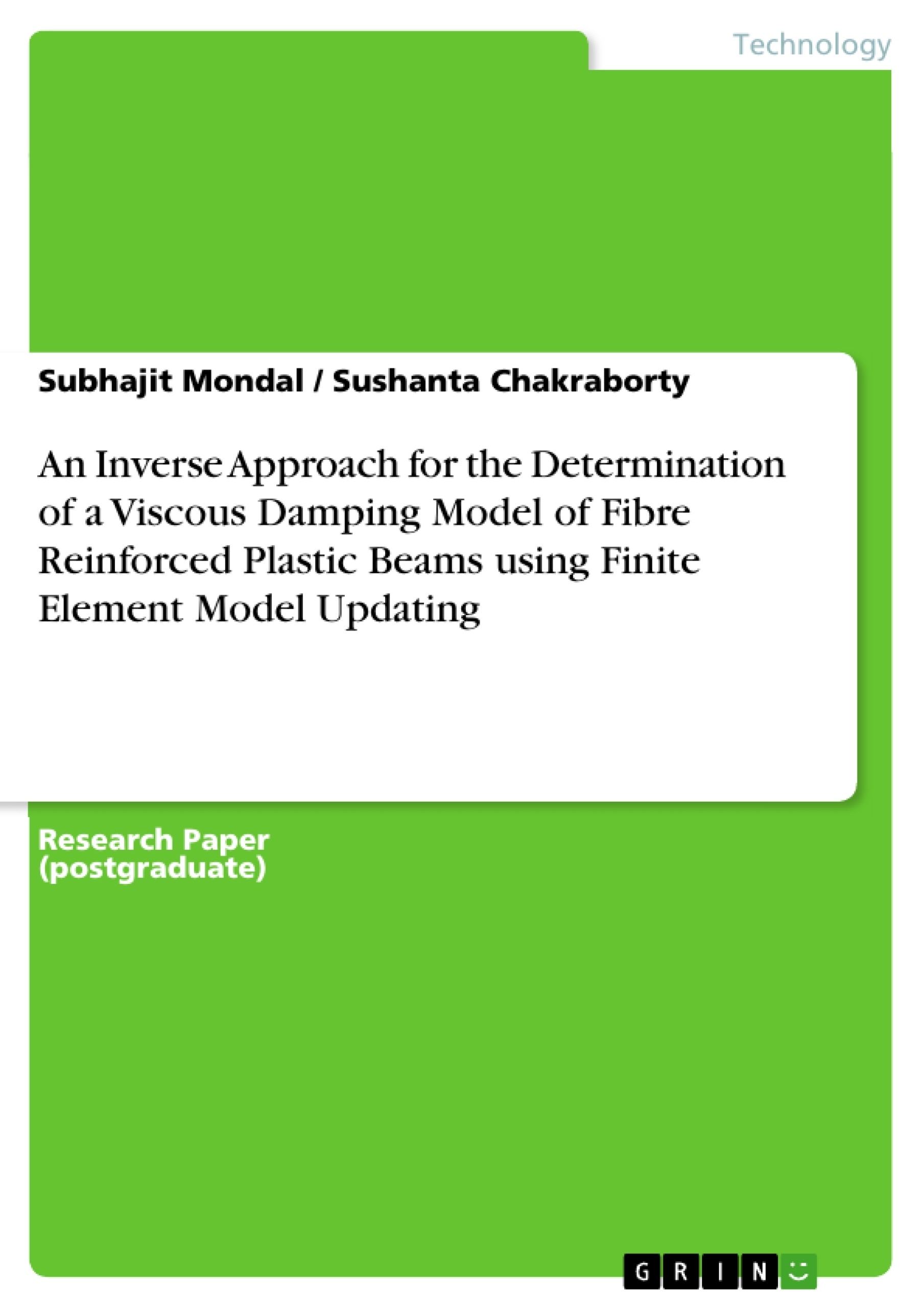Investigations have been carried out both numerically and experimentally to settle with a practically feasible set of proportional viscous damping parameters for the accurate prediction of responses of fibre reinforced plastic beams over a chosen frequency range of interest. The methodology needs accurate experimental modal testing, an adequately converged finite element model, a rational basis for correct correlations between these two models, and finally, updating of the finite element model by estimating a pair of global viscous damping coefficients using a gradient-based inverse sensitivity algorithm.
The present approach emphasises that the successful estimate of the damping matrix is related to a-priori estimation of material properties, as well. The responses are somewhat accurately predicted using these updated damping parameters over a large frequency range. In the case of plates, determination of in-plane stiffness parameters becomes easier, whereas for beam specimens, transverse material properties play a comparatively greater role and need to be determined. Moreover, for damping matrix parameter estimation, frequency response functions need to be used instead of frequencies and mode shapes. The proposed method of damping matrix identification is able to reproduce frequency response functions accurately even outside the frequency ranges used for identification.
Frequently asked questions
What is the primary objective of this investigation?
The objective of the present investigation is to apply a gradient-based model updating technique to estimate viscous damping parameters along with the stiffness parameters for pultruded FRP beams using measured FRFs.
Why is accurately determining dynamical responses important?
The accurate determination of dynamical responses is important from the viewpoint of safety, serviceability, and operation of any structure.
What factors influence the dynamic responses of a structure?
The geometrical complexities, material property distributions, existing boundary conditions, and applied loading are the key factors that influence the dynamic responses.
What are the challenges in predicting dynamic responses?
Uncertainties in response prediction remain due to imperfect boundary conditions and the presence of damping, which are difficult to deal with.
What does the damping mechanism comprise of?
The damping mechanism may comprise three effects -- material damping resulting from micro-structural behaviour, friction damping resulting from looseness at boundaries, and environmental damping effects, such as interaction with the surrounding fluid.
What is Fibre Reinforced Plastic (FRP) commonly used for?
Fibre Reinforced Plastics (FRP) have long been used in weight-sensitive aerospace, naval, automotive, and high-performance sports applications.
What are the advantages of using FRPs in infrastructures?
Durability, fatigue, and corrosion resistance.
What inverse technique can assess the stiffness and damping properties?
A reliable non-destructive inverse technique.
What makes uncertainties increase in damping parameters?
Uncertainties in damping parameters will further increase, as the mechanism may include one or more effects which were initially absent. For example, loosening of joints and supports may result in increased friction component of damping as time passes.
Why are there limited attempts to estimate inversely the damping parameters for FRP structures?
The main reason is that for small damping, the resonant frequencies and mode shapes change very little with damping coefficients, but the responses change drastically, especially near resonances.
What is the most popular forward damping model?
The most popular forward damping model is due to Rayleigh, in which the damping matrix is assumed as a weighted linear combination of the mass and stiffness matrix.
What does a successful model rely on?
A model's ability to replicate the actual observable responses over a frequency range of interests.
Why is the gradient-based model updating technique used?
To estimate viscous damping parameters along with the stiffness parameters for pultruded FRP beams using measured FRFs.
What is the process for identification of damping of FRP beams?
The complete process for identification of damping of FRP beams includes a-priori estimate of stiffness parameters using measured modal and FRF data, converged finite element modelling, correlations between them, and finally updating the global proportional damping parameters using the gradient-based inverse sensitivity technique in a nonlinear least square sense.
What is Modal Assurance Criteria (MAC) used for?
To determine how similar or dissimilar the analytical modal vector is as compared to the experimentally measured modes; a value close to 1 indicates good correlations.
What are Signature Assurance Criteria (SAC) and Cross Signature Assurance Criteria (CSAC)?
SAC is used to correlate analytical and experimental FRFs, while CSAC is a correlation function used to check the FRF correlations locally.
What does the inverse detection of damping using an iterative procedure demand?
Proper forward simulation of the damped responses of the FRP structures in the iterative loop.
What is Cross Signature Scale Factor (CSF)?
Cross Signature Scale Factor takes care of the amplitude correlations of FRFs.
What equation of motion is used?
The equation of motion of a multiple-degrees-of-freedom system in a discretized form is: M x''(t) + C x'(t) + Kx(t) = f(t).
What are the sensitivities of these FRFs computed?
Using Sij = H(ω)/δrj.
What is the relation between changes in measured modal properties and changes in parameters to be updated?
{δf} = [S]{δr}.
How is the stiffness more efficiently updated?
With the help of measured natural frequencies and mode shapes.
What is required to update damping matrix coefficients?
The information from measured FRFs.
What is the two-stage updating algorithm?
1 - Stiffness properties are updated prior to the updating of the damping parameters
2 - a-priori estimate of stiffness and damping is achieved from measure FRF data
- Quote paper
- Subhajit Mondal (Author), Sushanta Chakraborty (Author), 2014, An Inverse Approach for the Determination of a Viscous Damping Model of Fibre Reinforced Plastic Beams using Finite Element Model Updating, Munich, GRIN Verlag, https://www.grin.com/document/318609



